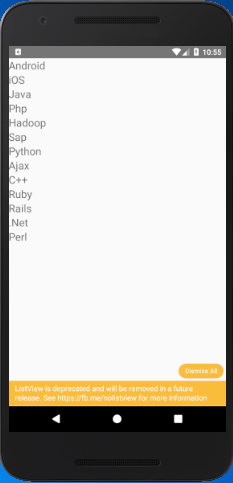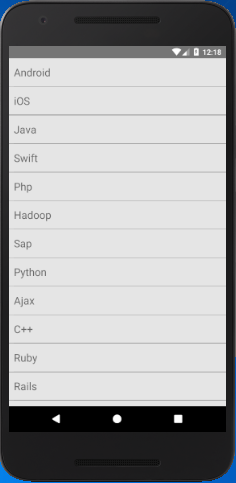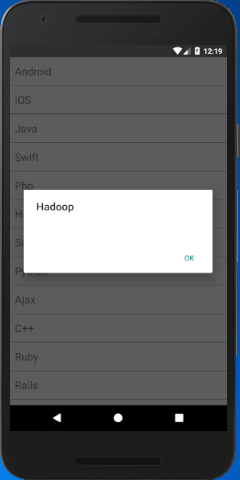React Native Tutorial
- React Native Tutorial
- React Native Environment Setups
- React Native First Application Hello World
- React Native View
- React Native State
- React Native Props
- React Native Style
- React Native Height and Width
- React Native Button
- React Native Layout and Flexbox
- React Native Positioning Element with Flex
- React Native ScrollView
- React Native ListView
- React Native FlatList
- React Native SectionList
- React Native Touchables
- React Native Text Input
- React Native ActivityIndicator
- React Native Picker
- React Native StatusBar
- React Native Switch
- React Native WebView
- React Native ProgressBarAndroid
- React Native ProgressBar With Animated
Navigation
- React Native Navigation
- React Native Configuring Header Bar
- React Native Moving Between Screens
- React Native Passing Value between Screen
- React Native Tab Navigation
- React Native Adding Icons at the Bottom of Tab Navigation
- React Native Create Material Bottom Tab Navigator
- React Native Top Tab Navigator
- React Native Drawer Navigation
Storage
React Misc
- React Native Google Map
- React Native Modal
- React Native Vector Icons
- React Native Splash Screen
- React Native vs. Ionic
- React Native vs. Xamarin
- React Native vs Flutter
- React Native vs React
- React Native vs Swift
- Box shadow in React Native
- React Native IAP
- React-Native Localization
- React Native Toast
- React Native Sound
React Native ListView
React Native ListView is a view component which contains the list of items and displays in a vertical scrollable list. The minimum API to create list view is ListView.DataSource. It populates a simple array of data blobs, and instantiate a ListView component with data source and a renderRow callback. The renderRow takes a blob from data array and returns a renderable component.
Note: The ListView component has deprecated. To implement the list component use new list components FlatList or SectionList.
React Native ListView Example 1
Let's create an example of ListView component. In this example, we create a data source, and fill it with an array of data blobs. Create a ListView component using that array as its data source, and pass it in its renderRow callback. The renderRow is a function which returns a component which renders the row.
import { Text, ListView, StyleSheet } from 'react-native'
export default class MyListComponent extends Component {
constructor() {
super();
const ds = new ListView.DataSource({rowHasChanged: (r1, r2) => r1 !== r2});
this.state = {
dataSource: ds.cloneWithRows(['Android','iOS', 'Java','Php', 'Hadoop',
'Sap', 'Python','Ajax', 'C++',
'Ruby', 'Rails','.Net', 'Perl']),
};
}
render() {
return (
<ListView
dataSource={this.state.dataSource}
renderRow={
(rowData) =>
<Text style={{fontSize: 20}}>{rowData}</Text>}
/>
);
}
}
Output:

In the above code, we create an instance of ListViewDataSource in the constructor. The ListViewDataSource is a parameter and accept an argument which contain any of these four:
- getRowData(dataBlob, sectionID, rowID)
- getSectionHeaderData(dataBlob, sectionID)
- rowHasChanged(previousRowData, nextRowData)
- sectionHeaderHasChanged(previousSectionData, nextSectionData)
Add separation and perform action on ListView items
Separation is added to provide a separate block and for better display of list items. The props renderSeparator is used to add separator among the items (data) of ListView.
Implement onPress props over Text to perform an action on clicking the list items. Here, we generate an alert message and display the list items on which a user click.
import { View, ListView, StyleSheet, Text,Alert} from 'react-native';
class ListViewDemo extends React.Component {
constructor(props) {
super(props);
const ds = new ListView.DataSource({rowHasChanged: (r1, r2) => r1 !== r2});
this.state = {
dataSource: ds.cloneWithRows([ "Android",
"iOS","Java","Swift",
"Php","Hadoop","Sap",
"Python","Ajax", "C++",
"Ruby", "Rails",".Net",
"Perl",
])
};
}
//handling onPress action
getListViewItem = (rowData) => {
Alert.alert(rowData);
}
render() {
return (
<ListView
style={styles.container}
dataSource={this.state.dataSource}
renderRow={(rowData) =>
<Text style={styles.rowViewContainer}
onPress={this.getListViewItem.bind(this, rowData)}>{rowData}
</Text>
}
renderSeparator={(sectionId, rowId) =>
<View key={rowId} style={styles.separator} />}//adding separation
/>
);
}
}
const styles = StyleSheet.create({
container: {
flex: 1,
backgroundColor: "#e5e5e5"
},
separator: {
height: 0.5, width: "100%", backgroundColor: "#000"
},
rowViewContainer: {
flex: 1,
paddingRight: 15,
paddingTop: 13,
paddingBottom: 13,
borderBottomWidth: 0.5,
borderColor: '#c9c9c9',
flexDirection: 'row',
alignItems: 'center',
fontSize: 20,
marginLeft: 10,
},
});
export default ListViewDemo;
Output:




